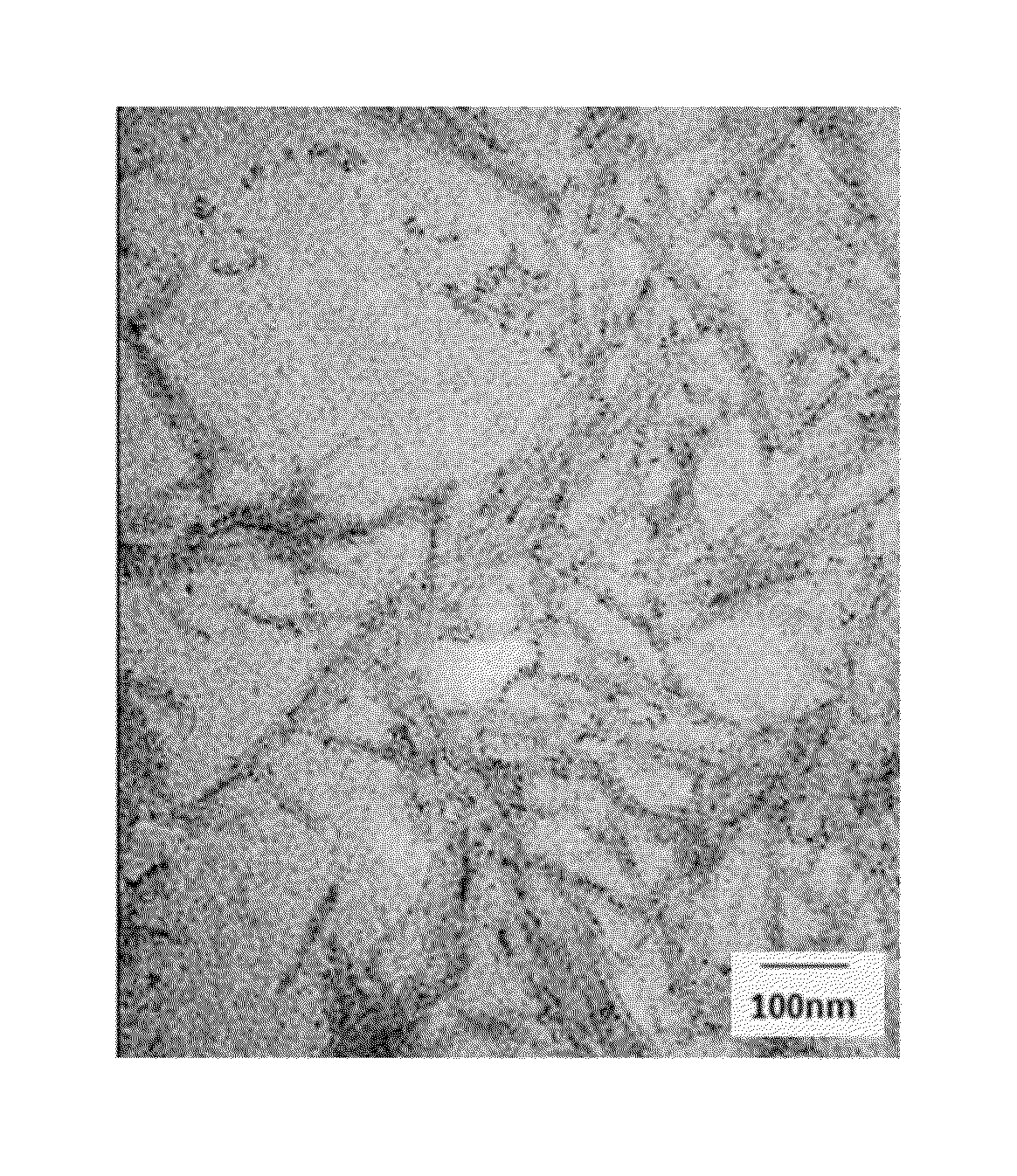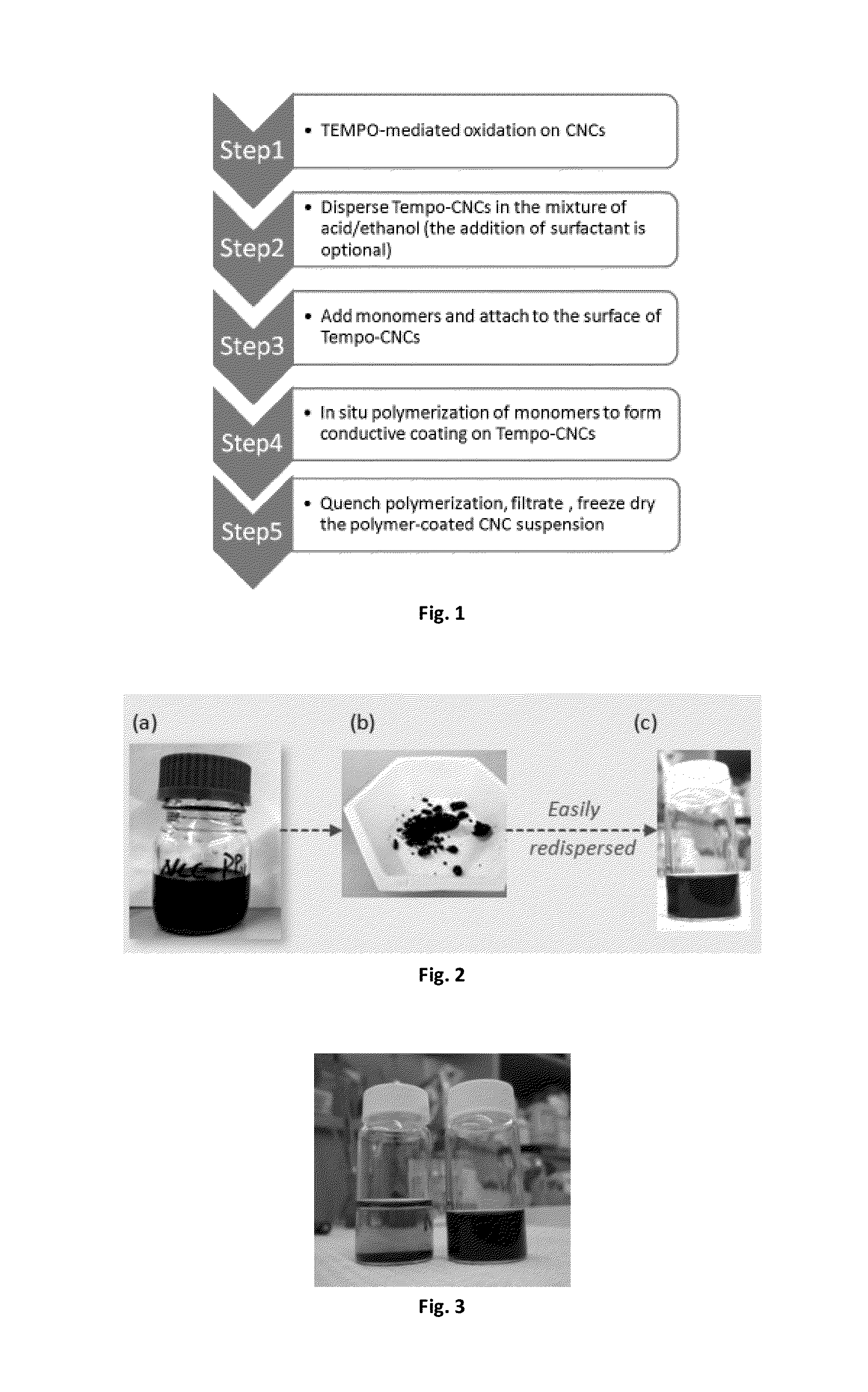Conductive cellulose nanocrystals, method of producing same and uses thereof
a technology of conductive cellulose and nanocrystals, which is applied in the direction of conductive materials, organic conductors, conductive materials, etc., can solve the problems of high cost of cnt, inability to meet the requirements of large-scale production, and difficulty in processing into useful products
- Summary
- Abstract
- Description
- Claims
- Application Information
AI Technical Summary
Benefits of technology
Problems solved by technology
Method used
Image
Examples
example 1
Fabrication of PPy / CNC Conductive Nanocomposite
[0089]TEMPO-mediated oxidation was first conducted on CNC, converting primary hydroxyls to carboxylate functionalities (Habibi, Y., Chanzy, H., Vignon, M. R., cellulose 2006, 13 (679)). About 120 mg freeze-dried Tempo-CNC was dispersed under sonication in the mixture of 1M HClO4 and ethanol (V / V=1 / 1) to produce a 0.2% wt suspension. 121.4 μL of pyrrole monomers were then added to the suspension and the mixture was transferred to a double-walled jacketed reaction vessel. The solution was vigorously stirred for 1 hour with circulation water running to maintain a temperature of between 0 to 5 degrees. The equal molar amount of ammonium persulfate (APS) dissolved in water (5 ml) was added dropwise to slowly initiate the polymerization. The color of the solution gradually turned from transparent to yellow, then to dark green and finally to black. This reaction was kept under magnetic stirring for 24 h at a temperature between 0 to 5 degrees....
example 2
Fabrication of Water-Soluble PPy / CNC Composite
[0091]To make water-soluble PPy / CNC nanoparticles, poly(styrene sulfonate) (PSS) of 60 mg (for every 120 mg CNCs) was added to the mixture of pyrrole monomers and CNCs before being transferred into the jacketed reaction vessel. The subsequent experimental procedures are identical to that described in example 1. The resulting product is referred below as PSS / PPy / CNC.
[0092]FIG. 3 shows the effect of pyrrole polymerization in the presence of the surfactant PSS. Both vials of the PPy / CNC suspension were kept undisturbed for 5 months. The one without adding PSS precipitated down but the other one with PSS remained homogenous and stable. While even for the precipitated PPy / CNC suspension, the suspension can be easily recovered to produce a uniform suspension upon shaking.
example 3
Characterizations of Conductive PPy / CNC Composite Material
[0093]FIG. 4 shows the transmission electron microscopic (TEM) image of the PPy / CNC using a Philips CM10 electron microscope. The TEM samples were prepared by depositing one drop of 0.01wt % sample dispersions onto a carbon coated TEM copper grid and dried at room temperature. From TEM pictures, the dimension and structural feature of CNC remained unchanged after coating with PPy.
[0094]FIG. 5 shows the thermal gravimetric analysis (TGA) test for Tempo-CNC, as well as the one coated with PPy. All samples were placed in inert ceramic crucibles and were heated from 25 to 700° C. at a heating rate of 10° C. / min in the presence of a 20 mL / min flow of air. The PPy / CNC composite was thermally stable up to 250 degrees and displayed a high weight retention at high temperature (more than 40% up to 400 degrees). The weight loss in the first stage of PPy / CNC decreased by ⅓ compared with CNCs without coating. This is mainly due to the pro...
PUM
| Property | Measurement | Unit |
|---|---|---|
| Time | aaaaa | aaaaa |
| Diameter | aaaaa | aaaaa |
| Length | aaaaa | aaaaa |
Abstract
Description
Claims
Application Information
 Login to View More
Login to View More - R&D
- Intellectual Property
- Life Sciences
- Materials
- Tech Scout
- Unparalleled Data Quality
- Higher Quality Content
- 60% Fewer Hallucinations
Browse by: Latest US Patents, China's latest patents, Technical Efficacy Thesaurus, Application Domain, Technology Topic, Popular Technical Reports.
© 2025 PatSnap. All rights reserved.Legal|Privacy policy|Modern Slavery Act Transparency Statement|Sitemap|About US| Contact US: help@patsnap.com



